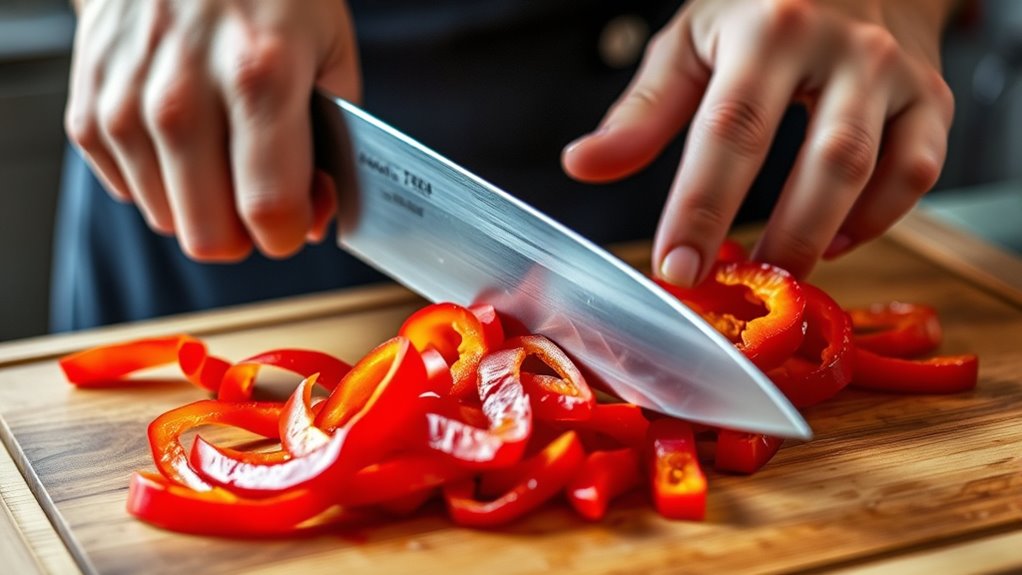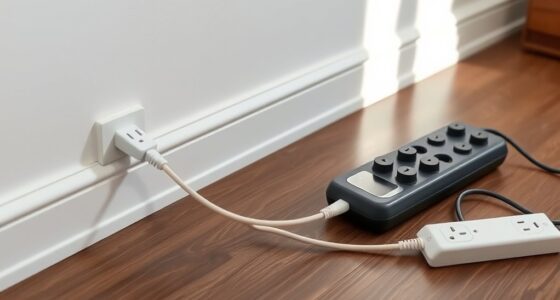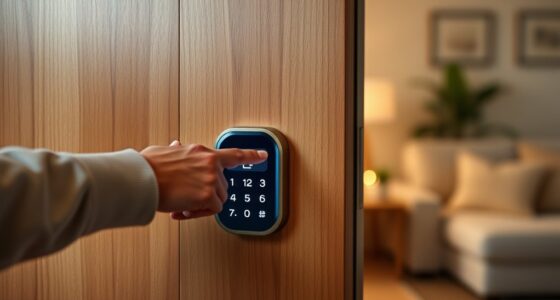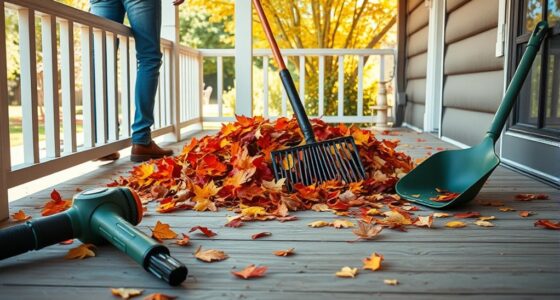To cook safely, master proper knife skills and cutting techniques. Hold the handle firmly with a pinch grip to maintain control, and tuck your fingertips in with a claw shape to protect them. Use a stable cutting board on a non-slip surface, and keep your knife sharp for precise cuts without applying excessive force. Practice controlled rocking motions, keeping the tip in contact with the board. Keep learning these techniques to cook more confidently and safely every time.
Key Takeaways
- Use the pinch grip to hold the knife firmly and maintain control during cutting.
- Place the cutting board on a non-slip surface with damp towels or silicone mats for stability.
- Keep knives sharp to reduce force needed and prevent slips, enhancing safety and precision.
- Use a controlled rocking motion, keeping the tip in contact with the cutting surface for safer slicing.
- Tuck fingertips inward on the guiding hand to protect fingers and ensure safe handling.
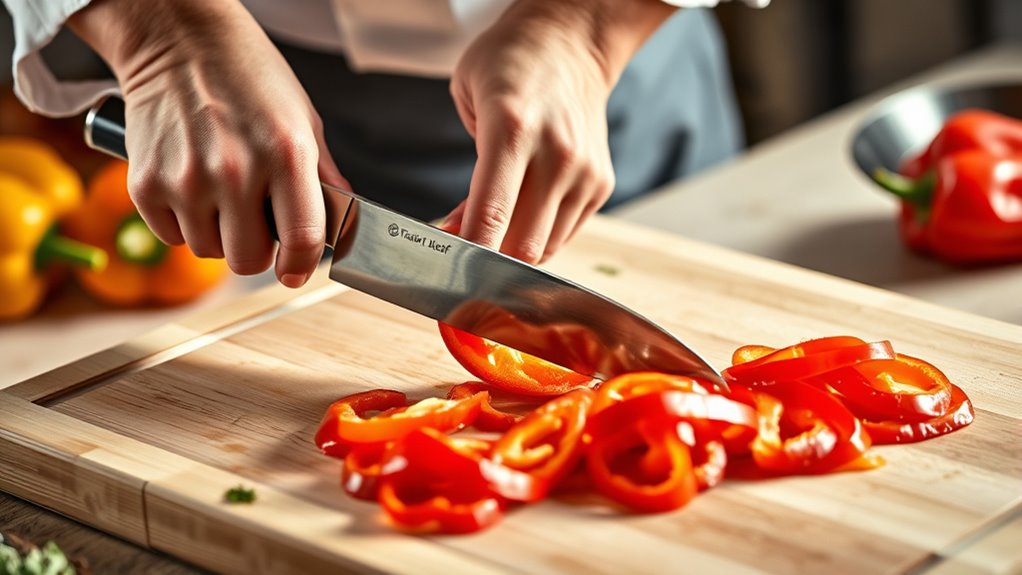
Cooking safely is essential to prevent accidents and guarantee your meals are healthy. One of the most important skills you can develop in the kitchen is proper knife handling. How you grip your knife and how you manage your cutting board can make a significant difference in avoiding injuries. When it comes to a knife grip, you want to hold the handle firmly with your dominant hand, but not so tight that your hand tenses up. The most effective grip is the pinch grip, where you secure the blade by pinching the blade’s base with your thumb and index finger while wrapping your remaining fingers around the handle. This grip gives you better control and reduces the risk of slipping. As you cut, keep your other hand in a claw shape, tucking your fingertips inward to protect them from the blade. This technique allows you to guide the knife while keeping your fingers safe and minimizes accidental cuts.
Cutting board safety is just as essential. Always place your cutting board on a stable, non-slip surface to prevent it from sliding as you work. You can put a damp towel or a silicone mat underneath to increase traction. Never leave your cutting board unstable or uneven, because a wobbly surface increases the chance of slipping and injury. When chopping, use a rocking motion with the knife, keeping the tip in contact with the cutting board and moving the handle up and down. This technique offers more control and reduces the chance of the knife slipping off the food or your hand. Also, be mindful of the size of your cutting surface — make sure it’s large enough to comfortably handle your ingredients without crowding. Always clean your cutting board thoroughly after each use, especially when switching between raw meats and vegetables, to prevent cross-contamination.
Practicing proper knife grip and cutting board safety isn’t just about avoiding injuries; it also makes your prep work more efficient. When your grip is secure and your cutting surface stable, you’ll find yourself slicing more precisely, which results in better-cooked dishes. Remember to pay close attention to your hand positioning, and avoid rushing through your cuts. Sharp knives are safer than dull ones because they require less force, reducing slips. Keep your knives sharpened regularly, and inspect your cutting board for cracks or deep grooves that can trap bacteria or cause uneven cuts. By consistently applying these safety measures, you’ll safeguard yourself from accidents and create a cleaner, more efficient kitchen environment. Proper technique in handling knives and managing your cutting surface is a fundamental step toward becoming a confident, safe cook.
Frequently Asked Questions
What Safety Gear Should I Wear When Using Knives?
When using knives, you should wear protective gloves to prevent cuts and a cutting apron to keep your clothes safe from spills and splatters. These safety gear items help you stay protected while handling sharp blades. Always make certain your gloves fit well and your apron covers your clothing. Using the right safety gear minimizes accidents, allowing you to focus on your cutting skills confidently and safely.
How Do I Prevent Cross-Contamination During Cutting?
To prevent cross-contamination during cutting, you should start with proper handwashing before handling ingredients. Use separate cutting boards for raw meats, vegetables, and other foods, and sanitize them regularly. Always clean your knives and utensils between tasks, and avoid placing cooked or ready-to-eat foods on contaminated surfaces. Following good sanitation practices and maintaining cleanliness helps keep your food safe and prevents the spread of germs.
What Should I Do if I Cut Myself?
If you cut yourself, stop cutting immediately and apply first aid. Rinse the wound with clean water and gently pat it dry. Apply pressure with a clean cloth to stop bleeding, then cover it with a sterile bandage. Keep the wound clean and watch for signs of infection. If the cut is deep or bleeding heavily, seek professional wound care promptly to prevent complications.
How Often Should I Sharpen My Knives?
Think of your knives as the heartbeat of your kitchen—keeping them sharp keeps everything flowing smoothly. You should sharpen your knives every 1 to 3 months, depending on how often you cook. Regular knife maintenance with proper sharpening tools guarantees they stay safe and efficient. If you notice dullness or difficulty cutting, it’s time to sharpen. Consistent care prevents accidents and prolongs their life, making cooking safer and more enjoyable.
Can I Use the Same Cutting Board for Raw Meat and Vegetables?
You shouldn’t use the same cutting board for raw meat and vegetables because of cross contamination risks. To keep your kitchen safe, dedicate separate boards or thoroughly wash and sanitize your cutting board between uses. Proper cutting board maintenance guarantees bacteria don’t spread, protecting you from foodborne illnesses. Always sanitize your cutting board after handling raw meat before chopping vegetables or other foods to maintain a hygienic cooking environment.
Conclusion
Mastering proper knife skills and cutting techniques keeps you safe in the kitchen and reduces accidents. Did you know that most kitchen injuries happen when handling knives? By honing your skills and staying attentive, you cut down your risk considerably. Remember, always focus on your task and use the right technique. Staying safe while cooking not only protects you but also makes meal prep more efficient and enjoyable. Keep practicing, and you’ll become a confident, safe cook in no time.
